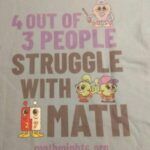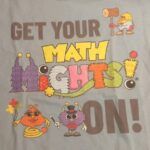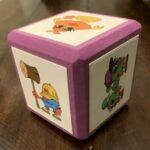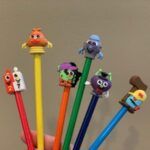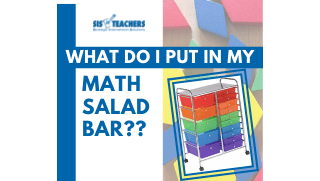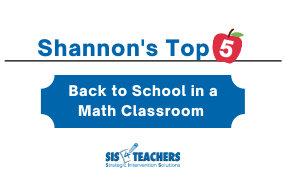As I’ve honed my craft of professional development, the strategic lens that I used in special education has continued to be my guide.
 However, instead of peeling back layers of students, I wanted to transition to more of a systems approach where I could help peel back the layers of a whole school to figure out why they were struggling in various areas like numeracy development or problem solving.
However, instead of peeling back layers of students, I wanted to transition to more of a systems approach where I could help peel back the layers of a whole school to figure out why they were struggling in various areas like numeracy development or problem solving.
Though I began my consultant career by focusing on preventing early learning failure and looking at the whole child – visual motor integration, ADHD and sensory integration, fine and gross motor development, and even reading sessions – I found that I needed to narrow my focus. I couldn’t be an expert in all these different areas in all the different grade levels. Math emerged as the subject in which there was a great need for professional development. I still do some of my ADHD sessions for Staff Development for Educators (SDE) conferences and we have a few motor development sessions on our website that I will do for schools, but I really wanted to shift and become an expert in this one area of math.
Molding My Professional Development Mindset
My approach as a presenter was very much influenced by my experience with professional development as a teacher. Maybe you can identify…the presenter has a whole host of great ideas, but you keep asking yourself Has this person actually taught in the classroom? How are these ideas actually going to work with kids who are really low, and don’t always get it when I teach it?
 I never wanted to be standing at the front of the room “delivering” professional development. I wanted to get into the classrooms so that you wouldn’t just hear us talking about these great ideas, but you could actually see them in action and see how they worked with YOUR students. Every classroom is different, so every implementation process is going to be different too, and I wanted teachers to see that the ideas and strategies we were presenting on had been tried and true and had been successfully implemented before with all kinds of kids, whether in more at-risk or more affluent situations.
I never wanted to be standing at the front of the room “delivering” professional development. I wanted to get into the classrooms so that you wouldn’t just hear us talking about these great ideas, but you could actually see them in action and see how they worked with YOUR students. Every classroom is different, so every implementation process is going to be different too, and I wanted teachers to see that the ideas and strategies we were presenting on had been tried and true and had been successfully implemented before with all kinds of kids, whether in more at-risk or more affluent situations.
With this in mind, I realized that “one-and-done” workshops were not the right avenue for me. I didn’t want to go to a district, do a six-hour training on model drawing, wish the teachers luck, and head home. Teachers are bombarded with so many different ideas, and though they have the best of intentions to implement them, they get overwhelmed and their new strategies just end up sitting on a shelf collecting dust. But I thought that, if someone were there to take that new strategy and implement it over time, we’d have more successful implementation.
This thought was solidified by my work on the TIPM program at our ISD. Teachers met with us in these grade band cohorts (K-2, 3-5, middle school, and high school)once a month to learn about a topic, if they needed manipulatives, we would supply those, and then there was a coaching component. The coaches would go on-site to the different schools to help with the implementation in the teachers’ classrooms and then would debrief in after-school collegial meetings about struggles and lessons learned. Sometimes schools would be able to send multiple teachers per grade level, but usually it was one representative from a grade level that was really benefiting from the project.
At the time, I was a presenter on the project, but I worked really closely with the coaches and was able to see the change that was taking place in teachers that were participating. They were really becoming more specialized in their craft, but then, because they were the representative from their grade level, they had to go back and try to teach everything that they were just learning to the rest of their colleagues. The result was piece-meal implementation at best, and I certainly didn’t see a whole school or district moving forward as a result of this program.
Making it My Own
I was involved with the TIPM project for quite a few years. I saw a lot of the things I’d learned about math and from other colleagues come together, and I learned a lot too, but I also had time to reflect and process. How did I want to present these courses? How did I want to deliver professional development. Could we do this better somehow? For my own practice, I saw a few major problems with the TIPM project. The first was that I really wanted to do more to move whole districts forward.
While helping individual teachers was effective, I again took a more strategic approach. What if we could, for the cost of sending one teacher to an amazing training that will ultimately only really impact one classroom, bring this to a district level and have consultants come to the school so the whole district can learn and implement the strategy through coaching? This was the inception of our specialized training series, which today is called M³, or Molding Math Mindsets, but at the time we just called it our Math Initiative or our Project Schools.
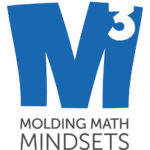
Though it varied by school, my goal was to get schools to commit to work with us for three or four years in order to really create sustainable change. For every day of professional development we delivered, it would be followed up with job-embedded coaching that was completely customizable. I might start by just observing and getting to know the district while coming up with an analytical plan. I might do one-on-one coaching with every single staff member where I could model screener administration or number talks or solving with CPA. Maybe I could do cluster coaching where I spend a two or three hour block in a classroom with all the teachers in that grade level to model a variety of things so we were all learning together. Maybe it could be all of the above!
Another major problem I saw with TIPM was that there were so many topics being covered at once. I wanted to slow down the process in order to make really good change happen. What if we took a whole year to learn about one topic, get really good at it and solidify the implementation before we moved on to another topic?
The final issue I saw was that, through TIPM, individual teachers had built their skills, had the support, and were fully implementing and showing success. But when we looked vertically from kindergarten all the way up to 5th grade, it was honestly a disjointed mess. Every teacher had a different way of doing things in their classroom, different strategies, different vocabulary, and kids were getting to fifth grade thoroughly confused.
My solution to these problems was to have teachers focus on one concept for the whole year – maybe just model drawings – and get really good at it to the point where they could apply it to the district-purchased math series. We could help them use the strategies we were teaching, not just in a “one-and-done” six-hour workshop, but through a systematic implementation with modeling and a journal for every student to help them become strong in this area.
Over time, these ideas came together to be the M³ series it is today – a systematic plan for school districts to adopt that will infuse change into whole schools.
I also wanted to use consultants that could work for Strategic Intervention Solutions that could be expert in various content areas, which would be ideal as they were implementing these strategies in the classroom. We worked with a lot of at-risk schools at that time. Many of the consultants I was working with either had dual degrees in general and special education, or at one time were Title 1 interventionalists, which gave them a different lens through which to view things.
My approach in this Math Initiative was just like my approach with my special education students: strategic. I tried to break it down into digestible pieces because, I knew from experience that teachers were already overwhelmed. Teachers are asked to jump on all the bandwagons all the time – new science, new writing, new English, new ideas left and right. And then, they are held accountable on their evaluation for their students’ performance. I think that is so unfair.
 Think about a doctor or think of any other skilled trade or profession. Imagine giving the engineers at Ford even just 10 new ideas to implement into their designs tomorrow, with the warning that, if the car doesn’t run, they would get fired. That would be ridiculous and unreasonable! Let’s make it even more challenging – and give them 25 different cars that they have to get running with all their new ideas. That’s what it’s like in our classrooms. Each student is different and has a different set of challenges to overcome. Kids don’t fit into a perfect mold, and yet we’re still asked to apply new ideas to our students like they are all the same.
Think about a doctor or think of any other skilled trade or profession. Imagine giving the engineers at Ford even just 10 new ideas to implement into their designs tomorrow, with the warning that, if the car doesn’t run, they would get fired. That would be ridiculous and unreasonable! Let’s make it even more challenging – and give them 25 different cars that they have to get running with all their new ideas. That’s what it’s like in our classrooms. Each student is different and has a different set of challenges to overcome. Kids don’t fit into a perfect mold, and yet we’re still asked to apply new ideas to our students like they are all the same.
We want to be very strategic in HOW we’re implementing new ideas so teachers feel comfortable and safe. Throughout our projects, we end up doing what’s called reverse coaching. Once we’ve developed trust and rapport with teachers so they feel comfortable with us in their classrooms, we get to watch them teach. Afterwards they come to us and ask questions like: Why isn’t this working the way I’m doing it? What am I doing wrong? How can I better help the kids? The good news is that they have a coach on-site with them to help make the needed changes right away.
Teachers have really been impacted by this series. I’ve had teachers who have told me that, in 20 years of teaching, they’ve never had anyone stand by their side and supported them along the way so that they feel successful in what they’re doing. I’ve had teachers who tell me they were looking forward to my workshops! I even had one teacher who came up to me after a six-hour workshop and said, “Take this as a compliment – I didn’t get any grading done today.”
I love seeing the success of teachers, and ultimately whole schools, that feel comfortable enough to be able to continue on their own after our contract ends. But more than that, I love being able to help change perspectives on math and math instruction. Of course, not every teacher is 100% on board. But I always try to think about working with the top 80%. If 80% of the teachers can understand where we’re going and what we’re doing, the other 20% can be birds on the wire, squawking. Eventually, they’ll join in or they won’t, but I’ve spent my time where I can make the most impact.
Molding Math Mindsets Today
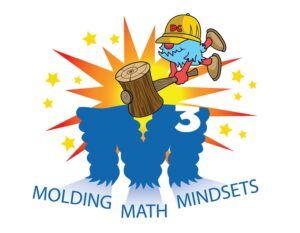 We now have M³ schools that have been working with us over the past four years and we’ve spread from having schools just in the Wayne County area where I live, to now having schools all over the state of Michigan that are really committed to change and are seeing results tremendous results.
We now have M³ schools that have been working with us over the past four years and we’ve spread from having schools just in the Wayne County area where I live, to now having schools all over the state of Michigan that are really committed to change and are seeing results tremendous results.
Kids that started in Kindergarten are now in 3rd grade and we’ve seen some incredible improvements in our state test scores. One of our at-risk districts had 17% of kids proficient in third grade on their state tests, and last year, after the kids had been through the M3 series, they increased to 45% of kids proficient. Another one of our schools that isn’t as at-risk went from 45% of students proficient to 69%. In some schools, 96% of Kindergarten students that have been through our numeracy training are now showing a year’s growth in a year’s time, compared to 57% before the training.
These numbers are what drive me because they represent the impact that we’re having on kids, the purpose behind what we do. It’s not about the fluff and the cuteness, but putting the theory into practice.
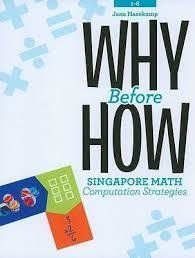 In addition to developing a strategic professional development plan for schools, another important component was a strategic support of that work through a product line. I never thought I’d have a warehouse in my house and ship different products all over the United States, but that’s what happened! We developed a number of different kits – numeracy, number sense, and model drawings – to go along with our trainings that use a lot of the different books and manipulatives and things available in our store. Early on, I partnered with SDE who, at the time, had a publishing company called Crystal Springs Books. That company went out of business, but we were able to keep the books out there because I actually inherited a lot of the resources that went with the math trainings I’d been doing with SDE, such as Singapore Math, as well as books by Kristin Hilty and Eliza Thomas-Sorte and even our own Jana Hazekamp!
In addition to developing a strategic professional development plan for schools, another important component was a strategic support of that work through a product line. I never thought I’d have a warehouse in my house and ship different products all over the United States, but that’s what happened! We developed a number of different kits – numeracy, number sense, and model drawings – to go along with our trainings that use a lot of the different books and manipulatives and things available in our store. Early on, I partnered with SDE who, at the time, had a publishing company called Crystal Springs Books. That company went out of business, but we were able to keep the books out there because I actually inherited a lot of the resources that went with the math trainings I’d been doing with SDE, such as Singapore Math, as well as books by Kristin Hilty and Eliza Thomas-Sorte and even our own Jana Hazekamp!
Though it didn’t start that way, through strategically filling needs that we saw, the M³ series has become a one-stop shop for math instruction in elementary. From professional development to coaching to the right tools, parent education (which we talked about last week!) and now adding on the curriculum blending piece, administrators have a whole menu of options that we can use to bring about systemic change in their districts.
Challenges
Of course, there are always challenges. With my strategic mindset, I always meet them head on!
One of the challenges we faced while trying to create that systemic change in math instruction in schools was that teachers saw it as “Shannon’s math” vs “regular math” that came from their district-purchased textbook. We work with eight different math programs, but we don’t cater to any of them because, honestly, I wouldn’t use book if I were teaching in a classroom! Teachers really wanted to do “Shannon’s math” but I wasn’t going page by page through their book. I was really only focusing on the areas where kids struggle – number sense and so forth – so they had trouble seeing how it all fit together.
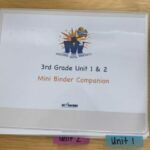 I had to figure out a way to make it more digestible for teachers, to help them see how the strategies we’re teaching are really embedded in their everyday practice. Our answer? We created units of study that could integrate all the important pieces that we were teaching in our trainings into the teachers’ daily routines. Check out our recent blog series for more on the curriculum design work we did – it was incredible!
I had to figure out a way to make it more digestible for teachers, to help them see how the strategies we’re teaching are really embedded in their everyday practice. Our answer? We created units of study that could integrate all the important pieces that we were teaching in our trainings into the teachers’ daily routines. Check out our recent blog series for more on the curriculum design work we did – it was incredible!
Another challenge was that teachers didn’t learn math the way I was teaching them to teach it. If you practice something over and over, it becomes habit, which is hard to break. For teachers and math, it becomes almost a phobia. These new strategies like partial sums and compensation are like a foreign language to teachers who struggle with feeling ignorant. “Why can’t we just teach it the traditional way that we learned it??” they wail! But we have to understand that our students are living in a very different time where innovation is the future, not just regurgitation. The old strategies of memorization won’t work. They have to learn to think.
This is partly why I called my training series “Molding Math Mindsets.” In order to be successful, I needed to really mold the mindset of the teacher first, so I could then help them to implement the new strategies and come on board with the things necessary for classrooms in the 21st century classroom. With the help of Kathleen Whitney, one of my amazing consultants for many years and a very dear friend, we came to the realization that, for teachers, math is only a small part of what they deal with on a daily basis. With everything going on for them, no wonder teachers can’t seem to remember the strategies I’ve explained to them 18 times already. Add to that the fact that one strategy might have nine different names in its lifetime, and we ultimately decided we needed to figure out a way to make new strategies more memorable for the teachers and more fun for the students. This was the seed from which our Math Mights characters grew!
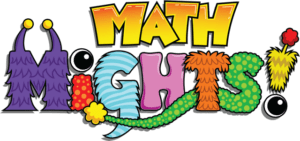
If I hadn’t gone to lunch at Potbelly’s with Connor one day, Math Mights might not exist as we know them today! While we were there, I found an ad on a bulletin board that advertised Johnny ‘Toons (https://johnnytoons.com/)– available for caricatures, artwork, etc. I thought it might be fun to get caricatures of the kids one day, so I took down his information and decided to call just to see what happened.
At first, I asked John to experiment by doing an avatar and a logo so I could get an idea of his work. He delivered the logo you are now familiar with, which feels much more representative of the work we do than our old one!
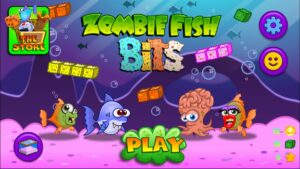 Happy with his work, I scheduled a meeting with him to talk about more potential work we could do together. I started to explain that I really want to come up with artwork that could help kids really understand some of these math practices like decomposing, and he goes, “I know what you’re talking about!” How ironic that the artist I connected with had also worked with Apple to create an app called Zombie Fish Bits where kids actually decomposed numbers!
Happy with his work, I scheduled a meeting with him to talk about more potential work we could do together. I started to explain that I really want to come up with artwork that could help kids really understand some of these math practices like decomposing, and he goes, “I know what you’re talking about!” How ironic that the artist I connected with had also worked with Apple to create an app called Zombie Fish Bits where kids actually decomposed numbers!
I described to him how I needed to find something that would help kids get excited about learning math strategies that, 1) wouldn’t have to be conditional to the eight different math programs that we were working with, and that 2) would be carry kids from 1st grade through middle school. You can read more about the development of Math Mights here!
As SIS4Teachers expanded, finding really great people to replicate the work that we were doing was a challenge. We needed people that were looking at making the journey an educator to entrepreneur and were comfortable assuming the risks that come with it, but that also had just the right amount of experience in education.
We are fortunate to have built a stellar team of consultants at SIS. Kathleen Whitney is really my right-hand woman. She has watched me present so many times that as soon as I start to think about getting an item to present with, she’s already handing it to me, but she still laughs at the jokes that she’s heard five times. Kathleen is able to connect with our teachers on a personal level that allows her to be such an incredibly effective coach. She’s been with us the longest, she’s integral to the success of SIS, and I don’t know where we’d be without her!
Tiffany Eller joined us most recently from Texas, and we’re very excited to have Jana Hazekamp come and do some work with us as well. I also really wanted someone that could really specialize in the middle and high school area and so my friend Eliza Sorte-Thomas referred me to Pat Baltzley who is our current middle and high school consultant. Pat’s background in curriculum writing and all the experience that she brings to the table is such an asset for our team!
 A good challenge I had came when I realized that my business was expanding and I was going to need help to run it. I went through a few assistants before Laura joined the team, but I’m so thankful for her! She is in the office every day to handle the behind-the-scenes stuff like billing, taking orders, etc. that I don’t enjoy doing. We also added Sherry to the team a few years ago, and even though we’ve never actually met in person, she manages the website and some of our social media, as well as coordinates the blog and some of our other publications. Having Laura and Sherry on the team has helped move SIS forward because I can spend more time on my craft and on the things I love, like my family, and less time on the things I don’t love, like billing and websites!
A good challenge I had came when I realized that my business was expanding and I was going to need help to run it. I went through a few assistants before Laura joined the team, but I’m so thankful for her! She is in the office every day to handle the behind-the-scenes stuff like billing, taking orders, etc. that I don’t enjoy doing. We also added Sherry to the team a few years ago, and even though we’ve never actually met in person, she manages the website and some of our social media, as well as coordinates the blog and some of our other publications. Having Laura and Sherry on the team has helped move SIS forward because I can spend more time on my craft and on the things I love, like my family, and less time on the things I don’t love, like billing and websites!
Looking to the Future
 You never really know what doors could be open if you don’t try to open it and see what’s on the other side. A door might close or it might open, but I know that if I didn’t push some of those doors open for myself, I wouldn’t be where I am today.
You never really know what doors could be open if you don’t try to open it and see what’s on the other side. A door might close or it might open, but I know that if I didn’t push some of those doors open for myself, I wouldn’t be where I am today.
But now that I’m here, what is the future of Strategic Intervention Solutions? As I look at the five freedoms that Suzanne Klein talks about, one of the things we talked about in our interview was that I haven’t exactly earned back my time freedom. Being a business owner and entrepreneur, a full-time presenter, author, innovator, a mom and a recently remarried wife, I love every single day of my life, but there are still a lot of things competing for my time.
In the future, I’d like to have more freedom of time and build more of an online library of resources. I would love for educators to be able to go on my website and, say they are teaching fractions, then be able to click on a short video review of how we did lego fractions or fraction tiles in their classroom that morning. Even though coaching takes a big chunk of my time, I never want to get away from the side-by-side or shoulder-to-shoulder work with teachers. There’s nothing more powerful than being on the job, in the midst of the chaos, learning together as we work with different kids.
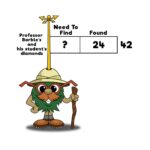 As far as publications, I would love to do more work in the area of model drawings, defining them with anchor charts, getting journals into classrooms, having answer keys available. I’d love to be able to build model drawing skills, and Professor Barble, the problem solving Math Might, might be making a new appearance in the near future!
As far as publications, I would love to do more work in the area of model drawings, defining them with anchor charts, getting journals into classrooms, having answer keys available. I’d love to be able to build model drawing skills, and Professor Barble, the problem solving Math Might, might be making a new appearance in the near future!
Our Math Mights line will also continue to grow in the future. We have been working with John to create some really exciting things! Although he is now working with a different company, before he left, he started helping us create some adorable little animated videos, and we also have some tutorial videos that are in final stages of production that will help make the ideas come alive. Math Mights swag will be coming your way soon – adorable pencil toppers, amazingly soft t-shirts, dice for different games…great things are on the horizon, so stay tuned!

